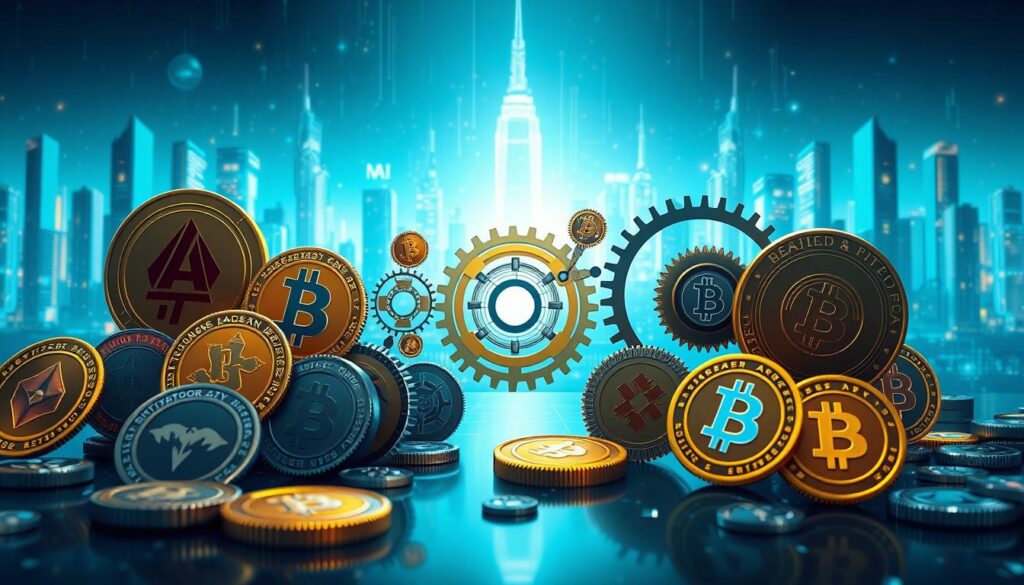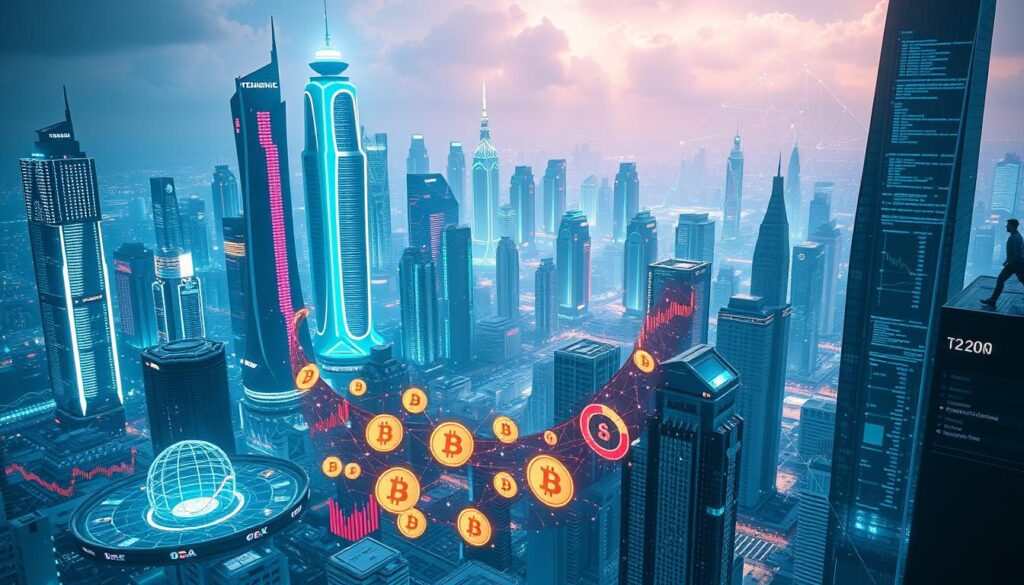Now Reading: Understanding AI Crypto Token Burn Mechanisms and Deflationary Models
- 01
Understanding AI Crypto Token Burn Mechanisms and Deflationary Models
Understanding AI Crypto Token Burn Mechanisms and Deflationary Models

Token burning refers to sending coins to a verifiable dead address to remove them from circulation. This creates provable scarcity on the blockchain and can change the balance between supply and demand over time.
Projects use smart contracts that emit events for auditability and front-end portals that let users connect wallets to initiate burns. Notable real-world examples include large, tracked burns on Solana, Cardano, and Shiba Inu that drew market attention.
Why developers adopt these approaches: transparent monetary policy can align incentives, reward holders as their share grows, and help teams communicate intent. Yet outcomes still hinge on adoption, utility, and broad market conditions over time.
Key Takeaways
- Token burning is a permanent, on-chain cut to supply to create scarcity.
- Deflationary mechanisms can help align project goals with holder interests.
- Dead addresses and on-chain events provide transparency and irreversibility.
- When supply tightens while demand holds steady, upward pressure on value may emerge.
- Real examples show these tools are used in production but results depend on adoption and time.
What token burning is and why deflationary mechanisms matter
Sending units to a verifiable dead address removes them from circulation and changes how supply meets demand. This practice lowers the total supply by making those units unusable forever.
Token burning basics
Developers send tokens to an eater address such as 0x000000000000000000000000000000000000dead to reduce the total supply. Over time this also trims the circulating supply, since fewer units remain in active circulation.
Deflationary pressure and scarcity
With steady or rising demand, fewer tokens chasing the same interest can create upward pressure on value. This scarcity may help price discovery when holders maintain confidence.
- On-chain events record each burn so holders can verify amounts and timing.
- Tokens circulation can drop via one-off burns or continuous methods like transaction-based removal, affecting liquidity differently.
- Projects must balance reducing circulating supply with maintaining enough liquidity for markets to function.
Best practices include publishing clear schedules, explaining total supply targets, and documenting logic behind reducing circulating supply so holders know what to expect.
Market context in the United States and 2024 trends
Data from mid-2024 points to a niche sector gaining traction among U.S. traders and holders. A snapshot shows roughly $4.34 billion in market cap, 28 tracked assets, and 0.20% sector dominance—small but notable within the larger market.
Rising adoption and signals of investor confidence
Upswings in price and trading volume are read as demand signals. When markets see steady growth, confidence in scarce supply tools often follows.
Examples shaping sentiment
- High-profile events, like Solana’s July 2022 removal of over 1.3 million SOL, reinforce execution credibility.
- Community portals can move markets quickly; SHIB’s 9.2 million removal in 24 hours preceded a 20%+ surge.
- U.S. anecdotes—Coinbase (2018) and Binance’s 2021 100 million action—help signal mainstream interest and higher exchange visibility.
Investor considerations: Liquidity, clear communication, and active community engagement shape perceived value over time. For many U.S. participants, visible data and timely reporting remain key to assessing long-term potential.
AI crypto token burn mechanisms and deflationary models
Some protocols remove supply per trade, while others repurchase units before sending them out of circulation. Each approach affects supply pace, predictability, and market signaling in different ways.

Burn-on-transaction, buyback-and-burn, and scheduled burns
Burn-on-transaction takes a small percent from every transfer. It reduces circulating amounts steadily and can encourage holding.
Buyback-and-burn uses project funds to repurchase units, then destroys them. This is an explicit commitment that can boost perceived value and demand.
Scheduled burns occur at set intervals. They are predictable and useful for signaling long-term supply plans.
Halving-style emission control vs. automated smart contracts
Halving-style events, like those found in Bitcoin, cut new issuance at set moments. That creates long-run scarcity through supply-side rules.
Automated smart contracts can coordinate continuous or event-based reductions. They offer finer control and instant verification on-chain.
Staking, lockups, and reflection rewards
Staking and lockups remove immediate availability by holding tokens out of circulation. Reflection rewards redistribute a portion of fees to holders, lowering net liquid supply.
Combined with fixed-percentage transfer designs used by projects such as Bomb Token (~1% per transfer) and Nuke Token (2% until a cap), these tools shape long-term supply trajectories.
- Trade-offs: immediate deflationary intensity vs sustainable usage and user costs.
- Choice should align with utility, lifecycle, and the broader cryptocurrency ecosystem served.
| Mechanism | Supply Pace | Predictability | Market Signal |
|---|---|---|---|
| Burn-on-transaction | Slow, continuous | Moderate | Encourages holding |
| Buyback-and-burn | Event-driven | Variable (company-controlled) | Strong commitment signal |
| Scheduled burns | Periodic | High | Planned scarcity |
| Halving-style emission | Long-term decline | High | Predictable supply shock |
For a deeper look at how a powerful deflationary approach works in practice, see this analysis.
How to design and deploy a burn-ready smart contract
A clear design phase sets parameters like name, symbol, decimals, and total supply before any code is written. This planning guides token development and reduces costly changes later.

Selecting a blockchain
Choose a chain based on throughput, fees, developer tooling, and user access. Common options are Ethereum for tooling, BNB Chain for lower fees, Solana for high throughput, and Polygon for EVM compatibility.
Define token parameters and tokenomics
Document name, symbol, decimals, total supply, burn rates, reflection rules, and governance hooks. Strong token development starts with clear tokenomics and versioned specs.
Engineering the burn function
Implement an external smart contract function that checks balances, adjusts supply accounting, and emits events for transparency. Route removed tokens to a known dead address such as 0x000000000000000000000000000000000000dead so they cannot return.
Testing, audits, and verification
Run unit, integration, and fuzz tests, then seek independent audits and listing services. Verify the contract on explorers and publish docs so projects can show how the deflationary mechanism works in practice.
Building the burn portal and user experience
Make the portal simple. Users should connect wallets, confirm a transaction, and see instant status without digging through menus. Clear language, visible progress, and short flows reduce errors and support requests.

Wallet connections, UI flows, and gas efficiency considerations
Support major wallets and common exchange wallets so participants from the US can join quickly. Show readable transaction summaries that explain which smart contract function will run.
Optimize gas by batching where possible and offering recommended gas presets. Guide users to the most efficient path on cost-sensitive chains to protect value.
Leaderboards, quests, and community engagement to drive participation
Gamified features increase community involvement. Leaderboards, seasonal quests, and badges reward top contributors and keep engagement steady.
Display cumulative stats: total tokens removed, recent activity, and top contributors. Add share buttons so achievements reach broader audiences and attract new participants.
| Feature | Benefit | Implementation tip |
|---|---|---|
| Wallet support | Lower signup friction | Integrate MetaMask, WalletConnect, and major exchange wallets |
| Gas optimization | Lower user costs | Batch calls; show gas estimates and presets |
| Gamification | Boost engagement | Leaderboards, quests, badges, and social shares |
| Transparency | Build trust | Readable receipts, on-chain links, and clear service notes |
Tokenomics features that support sustainable deflation
A resilient token plan pairs automatic market support with rewards that keep holders aligned over time. Clear design reduces volatility and helps value discovery as adoption grows.

Automatic liquidity pool acquisition
Automatic LP acquisition allocates a portion of each transfer to liquidity. That flow moderates volatility and sustains market depth.
Projects often route fees to a pool and pair them with base currency to shore up markets. For more on pool health, see analyzing liquidity pools.
Reflection rewards for long-term holders
Reflection redistributes a percent of transactions to holders. This creates passive income and encourages holding, which can lower tokens circulation over time.
Anti-whale and rate-limit strategies
Anti-whale rules cap transfers or apply progressive fees for large moves. These limits reduce manipulation and help preserve fair price discovery.
Balancing burn rates, liquidity, and utility
High removal percentages can strengthen scarcity signals but may hurt listings and usability if liquidity dries up. Responsible teams tune rates and keep governance flexibility to adapt as the ecosystem grows.
| Feature | Primary benefit | Impact on supply | Governance lever |
|---|---|---|---|
| Automatic LP contribution | Market depth, lower slippage | Neutral (supports liquidity) | Fee percentage, swap thresholds |
| Reflection rewards | Incentivizes holders | Reduces liquid supply over time | Reward share, claim intervals |
| Anti-whale limits | Prevents manipulation | Protects orderly markets | Max tx size, progressive fee tiers |
| Adaptive burn/utility balance | Long-term growth and listings | Managed scarcity | Adjustable rates via governance |
Recommendation: publish a public tokenomics scoreboard that tracks supply, burn rates, LP health, and distribution to keep key value drivers visible and measurable.
Compliance, security, and risk management in the US market
Regulatory scrutiny and sound security practices are now core requirements for any project aiming for US listings. Teams must pair legal review with technical controls to protect holders and meet exchange standards.
Regulatory considerations, transparency, and audits
Start with an early legal review that covers disclosures, AML/KYC, and state-level rules. US requirements change often, so build flexibility into operations.
Verify contracts on explorers and publish independent audit reports to improve transparency. Emit clear on-chain events for any supply moves so the community can confirm actions.
Smart contract security, multi-signature controls, and bug bounties
Use independent smart contract audits before mainnet launch. That reduces exploitable flaws and supports trust during listings.
Protect treasuries with multisig wallets for critical roles. Run a public bug bounty to surface issues fast and reward ethical finders.
Managing volatility, liquidity risks, and market-making
Disclose any buyback programs and set clear parameters to limit market surprises. Plan listings on compliant venues such as Binance, Coinbase, Kraken, or PancakeSwap for wider access and liquidity.
Create monitoring and incident runbooks for abnormal activity. Maintain thorough documentation of tokenomics, governance, and controls so regulators, partners, and holders can evaluate safeguards.
| Risk area | Recommended control | Expected benefit |
|---|---|---|
| Regulatory | Early legal review, AML/KYC policies | Lower compliance risk for US operations |
| Technical | Independent audits, multisig, bug bounties | Faster vulnerability detection and mitigation |
| Market | Disclosed buyback rules, market-making partners | Improved liquidity and reduced volatility |
From launch to long-term growth: optimizing burns for real outcomes
Note: Start by tying supply moves to measurable KPIs such as liquidity health, user retention, utility adoption, and price paths.
Iterate token development with staged tuning of burn rates, reflection shares, and LP allocations. Use dashboards to track supply contraction, market depth, and community behavior.
Apply AI/ML analytics sparingly to forecast demand scenarios and test smart contract upgrades that improve efficiency. Communicate schedule changes, buyback updates, and total supply milestones clearly to token holders.
Finally, pair scarcity tools with real utility, coordinate with exchanges and market makers, and keep the long-term balance between usability and supply discipline to drive sustained growth.















